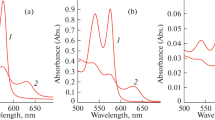Summary
Spectrin forms aggregates in solution when incubated at relatively high concentrations (several millimolar) of divalent cations. According to the evidence of electron microscopy, aggregates of globular appearance and, rather uniform size are cooperatively formed from spectrin dimers, no intermediate structures being seen. Inter-dimer chemical cross-linking of spectrin in intact red cell membranes is enhanced if magnesium ions at a concentration of 0.5mm or more are present. On the other hand, the elimination of magnesium from the interior of intact cells causes no significant change in shear elastic modulus, measured by micropipette assays, nor is there any dependence of membrane filtration rate on intracellular free magnesium concentration in the range 0–1mm. Magnesium-depleted cells are, however, converted into echinocytes within a short period, in which, control cells, exposed to ionophore and external magnesium ions, remain completely discoid. Magnesium-depleted cells also undergo structural, changes on heating below the temperature at which vesiculation sets in. These reveal themselves by the transformation of the cells to a unique characteristic shape, by grossly reduced filtrability, and by extensive agglutination of the cells when treated with a bifunctional reagent. Magnesium ions thus regulate the stability, but not to any measurable extent the gross elasticity, of the red cell membrane.
Similar content being viewed by others
References
Backman, L. 1986. Shape control in the human red cell.J. Cell. Sci. 80:281–298
Beaven, G.H., Gratzer, W.B. 1980. Interaction of divalent cations with human red cell cytoskeletons.Biochim. Biophys. Acta 600:140–149
Bessis, M. 1973. Red cell shpaes. An illustrated classification and its rationale.In: Red Blood Cell Shape. M. Bessis, R.I. Weed, and P. F. Leblond, editors. pp. 1–24. Springer Verlag, New York
Chasis, J.A., Mohandas, N. 1986. Erythrocyte membrane deformability and stability: Two distinct membrane properties that are independently regulated by skeletal protein associations.J. Cell. Biol. 103:343–350
Elgsaeter, A. 1978. Human spectrin: I. A classical light scattering study.Biochim. Biophys. Acta 536:235–244
Elgsaeter, A., Shotton, D.M., Branton, D. 1976. Intramembrane article aggregation in erythrocyte ghosts: II. The influence of spectrin aggregation.Biochim. Biophys. Acta 426:101–122
Engelhardt, H., Sackmann, E. 1988. On the measurement of shear elastic moduli and viscosities, of erythrocyte plasma membranes by transient deformation in high frequency electric fields.Biophys. J. 54:495–508
Evans, E.A. 1973. New membrane concept applied to the analysis of sheear micropipette-deformed red blood cells.Biophys. J. 13:941–954
Fischer, T.M., Haest, C.W.M., Stohs, M., Kamp, D. Deuticke, B. 1978. Selective alteration of erythrocyte deformability by SH-reagents. Evidence for the involvement of spectrin in membrane shear elasticity.Biochim. Biophys. Acta 510:270–282
Flatman, P.W., Lew, V.L. 1980. Magnesium buffering in intact human red blood cells measured using the ionophore A23187.J. Physiol. (London) 305:13–30
Fowler, V.M., Bennett, V. 1984. Erythrocyte tropomyosin. Purification and properties.J. Biol. Chem. 259:5978–5989
Gratzer, W.B. 1982. Preparation of, spectrin.Methods Enzymol.85:475–480
Kozlov, M.M., Markin, V.S. 1987. Model, of red blood cell membrane skeleton: Electrical and mechanical properties.J. Theor. Biol. 129:439–452
Laemmli, U.K., 1980. Cleavage of structural proteins during the assembly of the head of bacteriophage T4.Nature (London) 227:680–685
Mikkelsen, A., Elgsaeter, A. 1978. Human spectrin: II. An electrooptic study.Biochim. Biophys. Acta 536:245–251
Mohandas N., Chasis, J.A., Shohet, S.B. 1983. The influence of membrane skeleton on red cell deformability, membrane material properties and shape.Semin. Hematol. 20:225–242
Nakashima, K., Beutler, E. 1978. Effect of anti-spectrin antibody and ATP on deformability of resealed erythrocyte membranes.Proc. Natl. Acad. Sci. USA 75:3823–3825
Reich, M.H., Kam, Z., Eisenberg, H., Worcester, D., Ungewickell, E., Gratzer, W.B. 1982. Solution scattering studies of dimeric and tetrameric spectrin.Biophys. Chem. 16:307–316
Shields, M., LaCelle, P., Waugh, R.E., Scholz, M., Peters, R., Passow, H. 1987. Effects of intracellular Ca2+ and proteolytic digestion of the membrane skeleton on the mechanical properties of the red blood cell membrane.Biochim. Biophys. Acta 905:181–194
Shotton, D.M., Burke, B.E., Branton, D. 1979. The molecular structure of human erythrocyte spectrin.J. Mol. Biol. 131:303–332
Stokke, B.T., Elgsaeter, A. 1981. Human spectrin: IV. A viscosity study.Biochim. Biophys. Acta 640:640–645
Stokke, B.T., Mikkelsen, A., Elgsaeter, A. 1986a. The human erythrocyte membrane skeleton may be an ionic gel: I. Membrane mechanical properties.Eur. Biophys. J. 13:203–218
Stokke, B.T., Mikkelsen, A., Elgsaeter A. 1986b. The human erythrocyte membrane skeleton may be an ionic gel: III. Micropipette aspiration of unswollen erythrocytes.J. Theor. Biol. 123:205–211
Stokke, B.T., Steck, T.L. 1989 Elasticity of the human red cell membrane skeleton. Effects of temperature and denaturants.Biophys. J. 55:255–262
Waugh, R.E., Agre, P. 1988. Reduction of erythrocyte membrane viscoelastic coefficients reflect spectrin deficiency in hereditary spherocytosis.J. Clin. Invest. 81:133–141
Waugh, R.E., Evans, E.A. 1979. Thermoelasticity of red blood cell membrane.Biophys J. 26:115–132
Author information
Authors and Affiliations
Rights and permissions
About this article
Cite this article
Beaven, G.H., Parmar, J., Nash, G.B. et al. Effect of magnesium ions on red cell membrane properties. J. Membrain Biol. 118, 251–257 (1990). https://doi.org/10.1007/BF01868609
Received:
Revised:
Issue Date:
DOI: https://doi.org/10.1007/BF01868609




